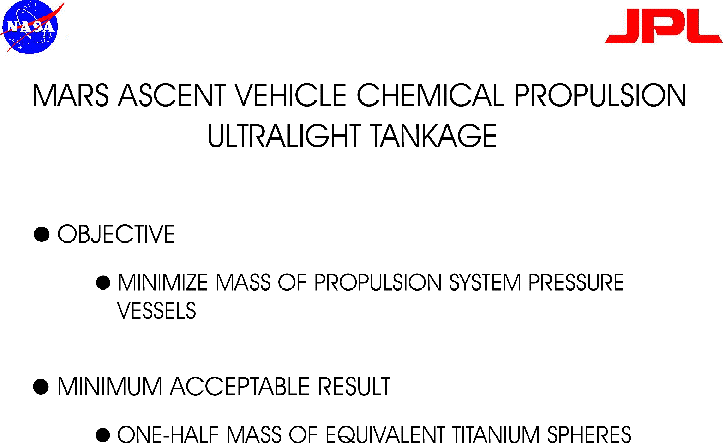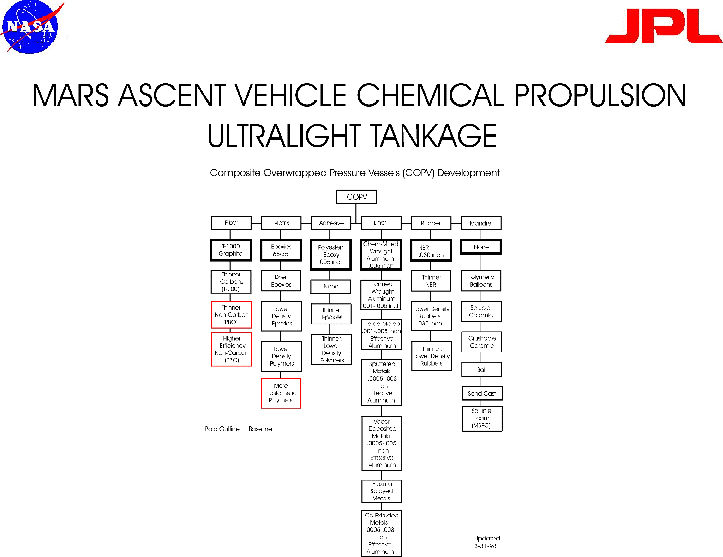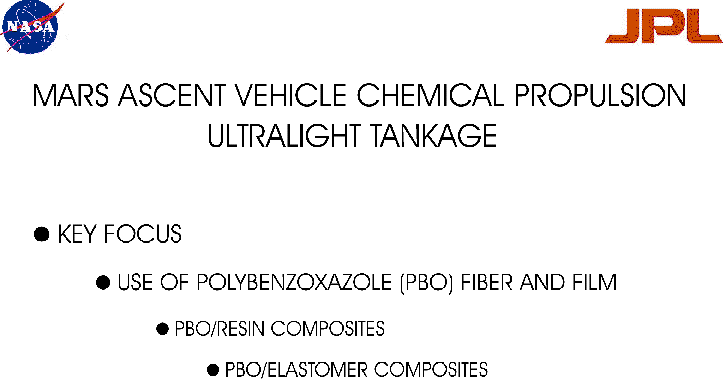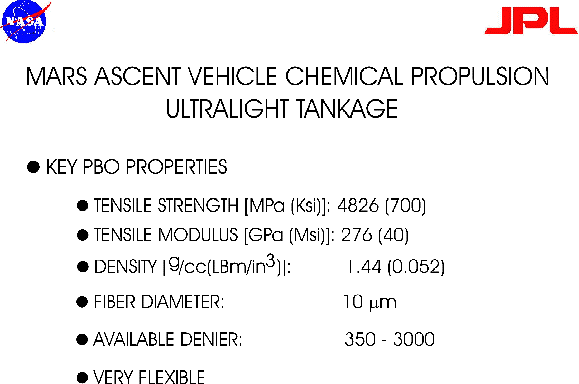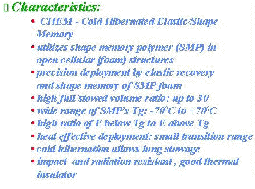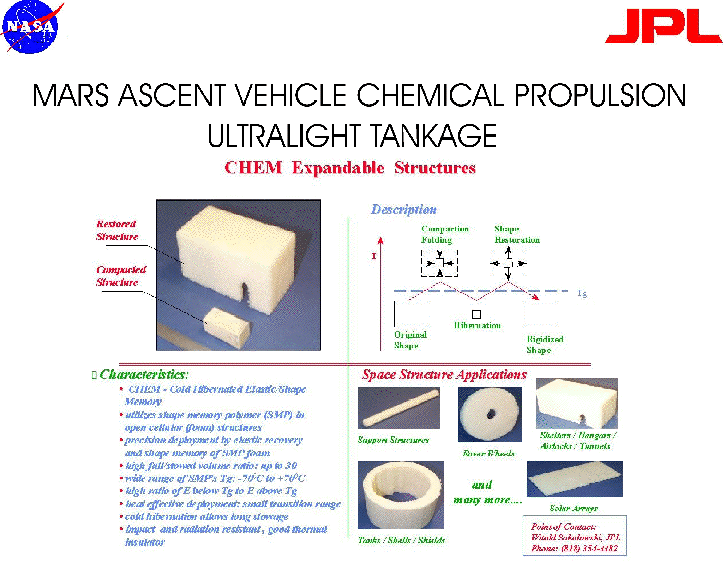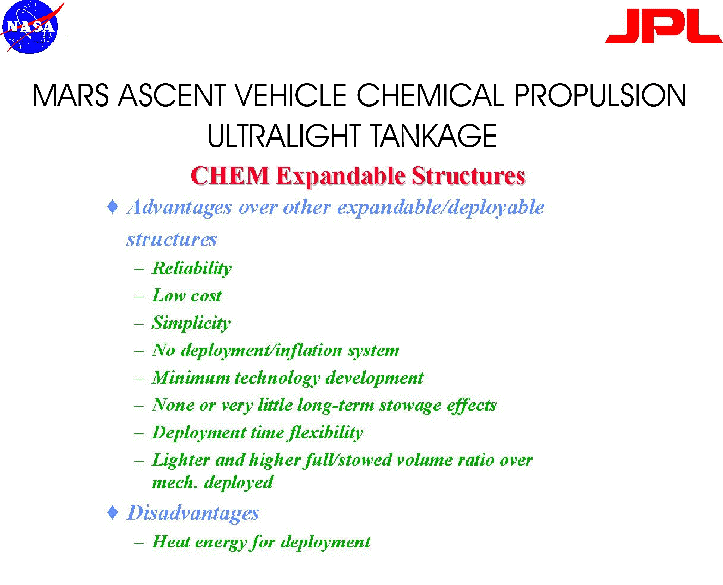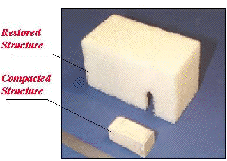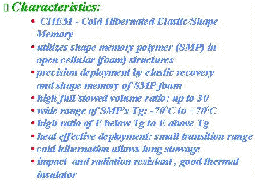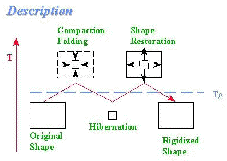Igloo Space Ship, remainder of viewgraph
presentation
3 nov 1998, a zuppero
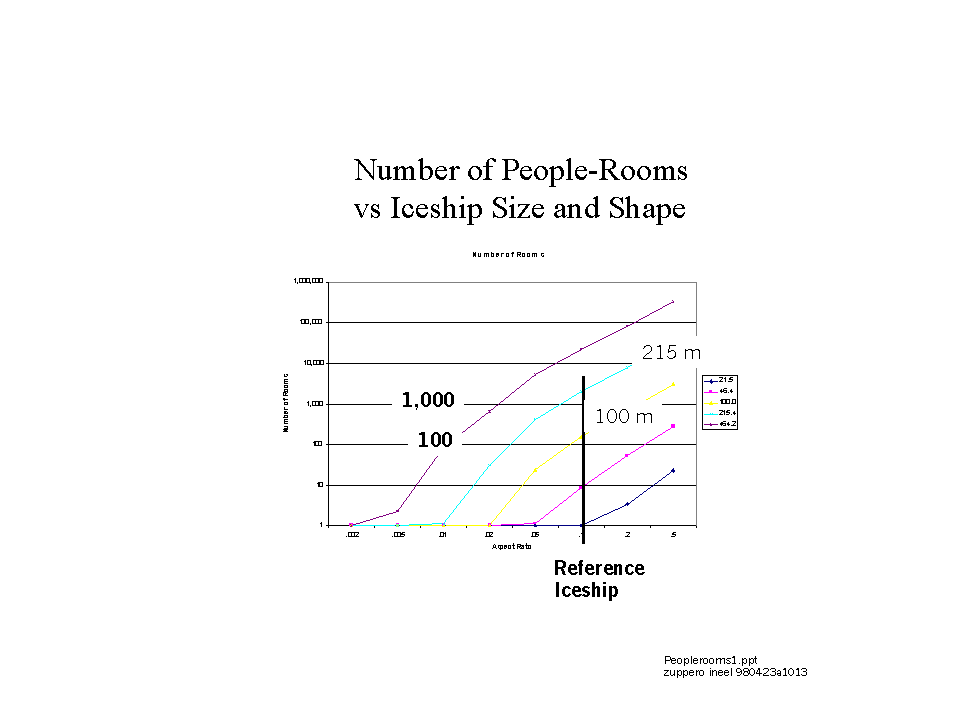 |
| VG #2 how big for 100 or 1000 people?
= 100 meter diameter for 150 people
= 215 m, 1900 people
will ice rip and break from the centrifugal force and fly apart? people
dumped into space, blood bursting from their eyes; pain torture exploding
eardrums; trying to scream, but ho air in their lungs? how much ice? |
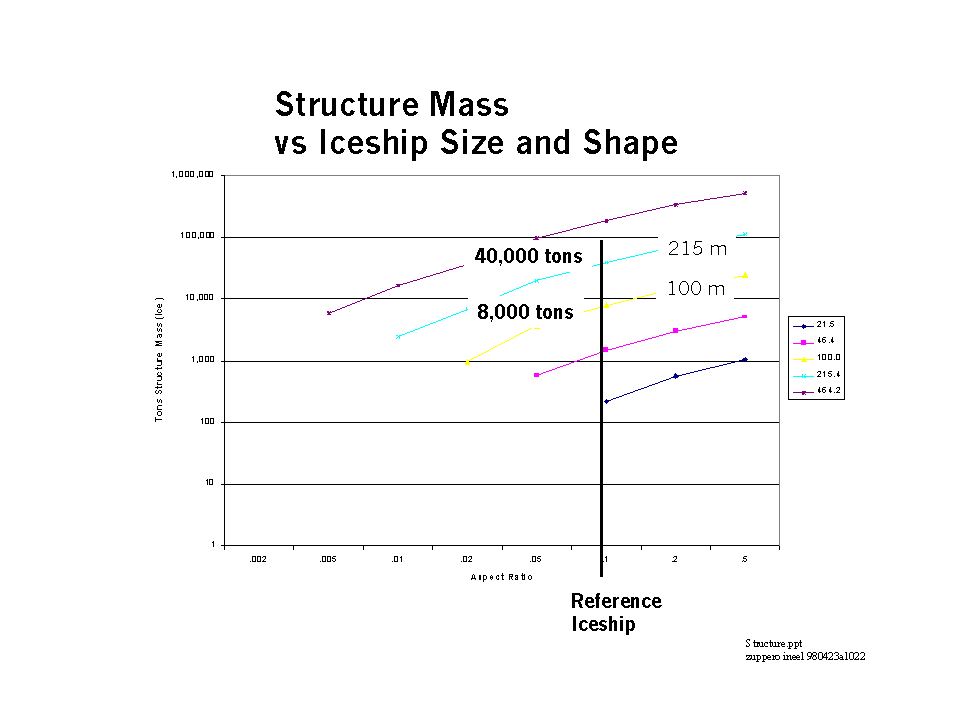 |
VG #3 How much ice?
100 meter diameter ship needs: 8000 tons, 215 m ship: 40,000
tons
That is only 1 zuppmobile shipment per year,
3 zuppmobile per year for the big ship.
How heavy is parachute cloth bag? that is a "Tank" |
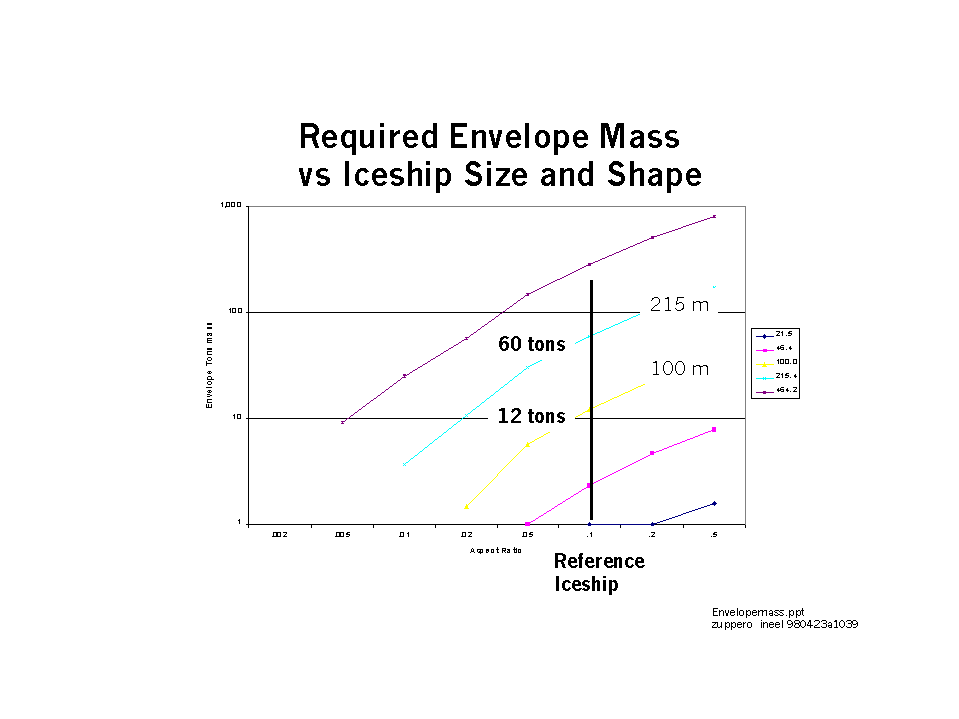 |
VG #4 parachute cloth enveope: how heavy?
Joe Lewis says: polybenzoxazole PBO, 700,000 psi yield strength. density
1.44, safety factor 2; He would make a 5 mill weave of fine
PBO fibers, and then cover the inside with a film layer to keep the water
from leaking out. the bladder tank would be collapsible so one can
launch it in a physically compact form.
100 m ship: water tank bladder weighs 12 tons, fits in 1/2 the
Shuttle bay
215 m ship bag weighs 60 tons, launch it instead of the Shuttle
"Shuttle" is only a familiar nominal space vehicle to compares sizes
and masses to.
But will space freeze it enough soit will not fly apare? Do we
need to haul a refrigerator inot orbit? Better not, or we are dead. |
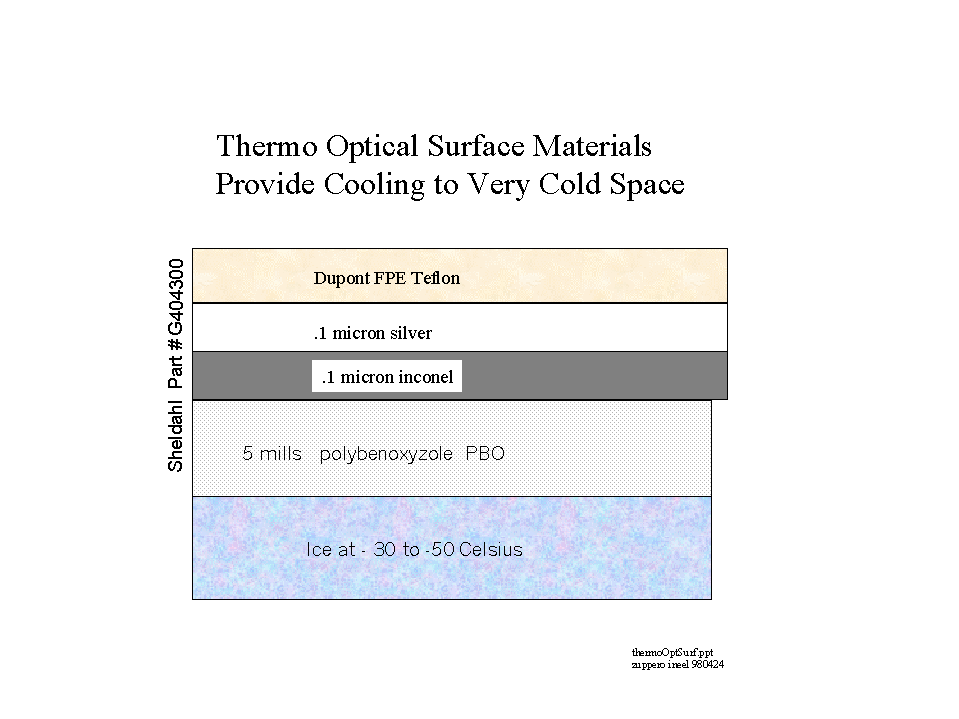 |
VG #5 space refrigerator
At Earth's distance from the sun, a ship coated with Sheldahl Part
Number G404300 will cool to -110 Celsius.
This coating is Dupont FPE Teflon on 0.1 micron Silver, on .1 micron
nickel. It costs $1000 per square meter in 1 meter quantities. They can
really drop cost for 10,000 square meter orders. They are a relatively
small company.
a = .1, e= .85, 5 mill thick, a/e gives --> -110 Celsius,
-170 Kelvin at 1 A.U.
charts include this mass
We still haven't answered the key question:
will it fly apart? |
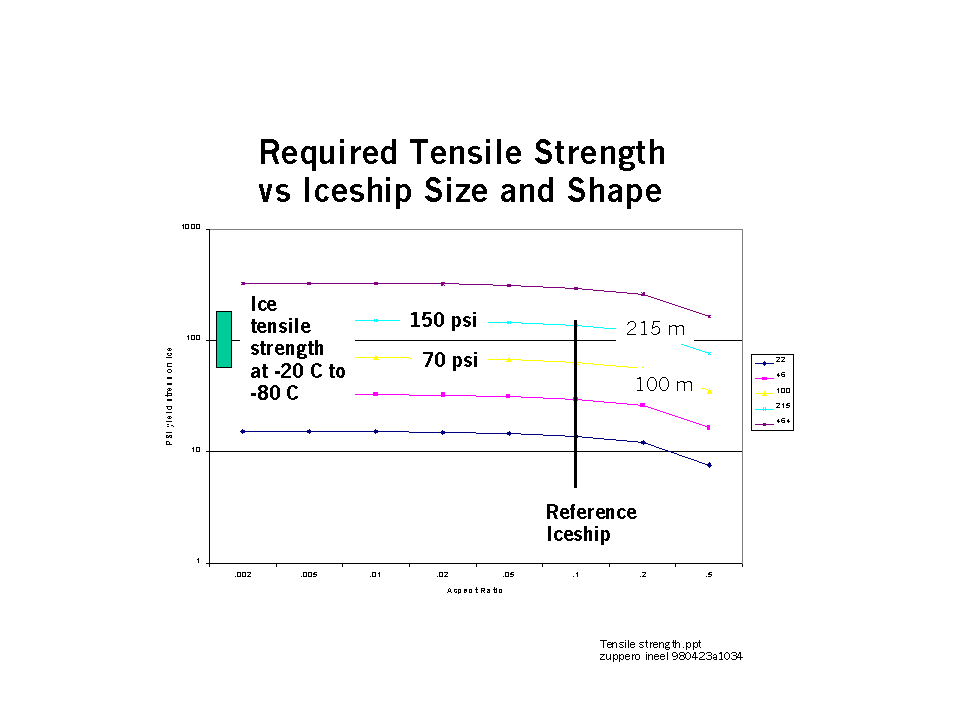 |
VG #6 Ice is Brick when cold. WONT
fly apart.
-20 C ice is ok for moon gravity,
-80 C ice is ok for earth gravity |
JOE LEWIS's Viewgraphs
joe couldn't make it to meeting, but sent viewgraphs
representing some of the Mars mission work on ultra-light tankage.
Using Joe Lewis design methods we believe a 500 to 1 fuel/tank ratio (.2%
tankage factor) can be readily achieved. the theoretical limit is more
like 10,000 to 1 for a tank that can be completely emptied of water, in
a milli-g environment. We would design for 300 milliG (about 2 times gravity).
Other points:
? PBO can do job without ice tensile strength.
? Didn't know about this until Joe Lewis showed me.
digging structures without a drill rig
ice like weak brick
creeps
? don't know how much, at -30 C
? really don't know how much creep at 125 Kelvin, like moon poles and
Moons of Jupiter
? pressure just above tripple point,
? so bubbles condense and dissappear
--------------------------------
digging
hot shovel, gets big cakes
hot cynlinder, core drills
hot iron on a rotating mandril, digs whatever your computer says.
collect the vapors
condense the vapors to get water
there should be other things in there too, hard to distill away.
| Ys |
700000 |
psi |
yield stress of envelope material |
| F |
3 |
1 |
safety factor for Ys |
| Po |
0.1 |
psi |
vapor Pressure mass from space |
| G |
9.8 |
m/s^2 |
max centripital G's |
| Tr |
100 |
g/cm^2 |
radiation shielding thickness |
| rho_s |
1 |
g/cm^3 |
density structure |
| rho_b |
3 |
g/cm^3 |
density envelope mass |
| Vh |
92 |
m^3 |
volume per human, cubic meters |
| millsgagelim |
10 |
mills |
gage limit |
| k |
|
1 |
tube diameter / ship diameter |
| Ys |
700000 |
psi |
yield stress of envelope material |
| F |
3 |
1 |
safety factor for Ys |
| Po |
0.1 |
psi |
vapor Pressure mass from space |
| G |
9.8 |
m/s^2 |
max centripital G's |
| Tr |
100 |
g/cm^2 |
radiation shielding thickness |
| rho_s |
1 |
g/cm^3 |
density structure |
| rho_b |
3 |
g/cm^3 |
density envelope mass |
| Vh |
92 |
m^3 |
volume per human, cubic meters |
| millsgagelim |
10 |
mills |
gage limit |
| k |
|
1 |
tube diameter / ship diameter |
| structure mass |
|
|
|
|
|
| tons |
|
|
|
|
|
| |
21.5 |
46.4 |
100.0 |
215.4 |
464.2 |
| .002 |
|
|
|
|
|
| .005 |
|
|
|
|
6,018 |
| .01 |
|
|
|
2,429 |
16,513 |
| .02 |
|
|
967 |
6,894 |
37,185 |
| .05 |
|
575 |
3,750 |
19,739 |
96,647 |
| .1 |
221 |
1,501 |
7,994 |
39,315 |
187,245 |
| .2 |
563 |
3,035 |
15,001 |
71,595 |
336,547 |
| .5 |
1,039 |
5,087 |
24,180 |
113,463 |
529,293 |
| structure mass |
|
|
|
|
|
| tons |
|
|
|
|
|
| |
21.5 |
46.4 |
100.0 |
215.4 |
464.2 |
| .002 |
|
|
|
|
|
| .005 |
|
|
|
|
6,018 |
| .01 |
|
|
|
2,429 |
16,513 |
| .02 |
|
|
967 |
6,894 |
37,185 |
| .05 |
|
575 |
3,750 |
19,739 |
96,647 |
| .1 |
221 |
1,501 |
7,994 |
39,315 |
187,245 |
| .2 |
563 |
3,035 |
15,001 |
71,595 |
336,547 |
| .5 |
1,039 |
5,087 |
24,180 |
113,463 |
529,293 |
| Ys |
700000 |
psi |
yield stress of envelope material |
| F |
3 |
1 |
safety factor for Ys |
| Po |
0.1 |
psi |
vapor Pressure mass from space |
| G |
9.8 |
m/s^2 |
max centripital G's |
| Tr |
100 |
g/cm^2 |
radiation shielding thickness |
| rho_s |
1 |
g/cm^3 |
density structure |
| rho_b |
3 |
g/cm^3 |
density envelope mass |
| Vh |
92 |
m^3 |
volume per human, cubic meters |
| millsgagelim |
10 |
mills |
gage limit |
| k |
|
1 |
tube diameter / ship diameter |
| envelope mass |
|
|
|
|
|
| tons |
|
|
|
|
|
| |
21.5 |
46.4 |
100.0 |
215.4 |
464.2 |
| .002 |
|
|
|
|
|
| .005 |
|
|
|
|
9 |
| .01 |
|
|
|
4 |
25 |
| .02 |
|
|
1 |
11 |
57 |
| .05 |
|
1 |
6 |
30 |
148 |
| .1 |
1 |
2 |
12 |
60 |
286 |
| .2 |
1 |
5 |
23 |
109 |
514 |
| .5 |
2 |
8 |
37 |
173 |
808 |
| |
|
|
|
|
|
| |
|
|
|
|
|
| |
|
|
|
|
|
| |
|
|
|
|
|
| Number of rooms |
|
|
|
|
|
| per person |
|
|
|
|
|
| |
21.5 |
46.4 |
100.0 |
215.4 |
464.2 |
| .002 |
1 |
1 |
1 |
1 |
1 |
| .005 |
1 |
1 |
1 |
1 |
2 |
| .01 |
1 |
1 |
1 |
1 |
87 |
| .02 |
1 |
1 |
1 |
31 |
648 |
| .05 |
1 |
1 |
24 |
423 |
5,320 |
| .1 |
1 |
9 |
155 |
1,987 |
22,102 |
| .2 |
3 |
54 |
696 |
7,805 |
82,164 |
| .5 |
23 |
281 |
3,090 |
32,291 |
329,489 |
| |
|
|
|
|
|
| |
|
|
|
|
|
| |
|
|
|
|
|
| |
|
|
|
|
|
| tensile stress required of structure mass |
|
|
|
|
|
| psi |
|
|
|
|
|
| |
22 |
46 |
100 |
215 |
464 |
| .002 |
15 |
33 |
71 |
152 |
329 |
| .005 |
15 |
33 |
71 |
152 |
328 |
| .01 |
15 |
33 |
70 |
151 |
326 |
| .02 |
15 |
32 |
70 |
150 |
323 |
| .05 |
15 |
31 |
67 |
145 |
313 |
| .1 |
14 |
30 |
64 |
138 |
296 |
| .2 |
12 |
26 |
57 |
122 |
263 |
| .5 |
8 |
16 |
35 |
76 |
165 |





